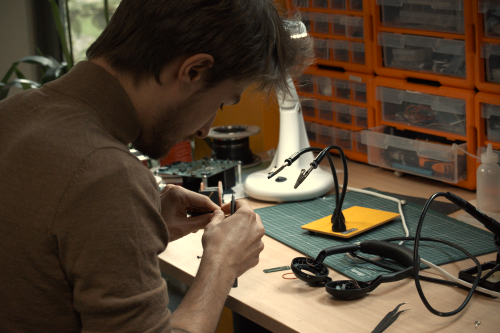The challenges of a deeptech startup

Innovation doesn’t happen overnight, especially when science is at its core. Deeptech startups are those rare ventures that transform breakthrough research into tangible products capable of changing the world. Unlike software companies that can iterate in weeks, deeptech firms face years of R&D, industrial hurdles, and complex ecosystems before reaching the market.
Skyted, born from aerospace and acoustics research, is one of them. Our mission: to bring silent, secure communication to everyone, everywhere. But behind every innovation like the Skyted 320, there are years of experimentation, engineering challenges, and perseverance.
What is a deeptech startup?
A deeptech startup is a company built around a scientific or technological breakthrough. Its goal is not to replicate existing markets but to create new ones, by applying research in physics, materials science, AI, or acoustics to solve fundamental human or industrial problems.
These startups are often founded by scientists, engineers, or research institutions. They focus on technological feasibility first, then work toward business scalability. Deeptech companies typically require:
- Long development cycles: technology must move from lab prototype to reliable, certifiable product.
- High technical risk: success depends on solving scientific and engineering unknowns.
- Heavy capital investment: building, testing, and certifying hardware requires substantial funding.
- Cross-disciplinary teams: combining science, business, design, and manufacturing expertise.
Skyted perfectly fits this definition. Our technology originated in aerospace acoustic research, developed in collaboration with the ONERA (National Office for Aerospace Studies and Research), and was later adapted into a commercial product that redefines how people communicate in mobility.
Why deeptech is such a challenge
Long development cycles
A deeptech startup’s timeline is nothing like that of a typical tech company. It can take years to go from idea to industrial product. For Skyted, transforming laboratory prototypes of acoustic materials into a functional headset required advanced testing, sound modeling, and integration with digital algorithms.
Funding and capital intensity
Deeptech ventures are expensive by nature. Investors accustomed to rapid returns may hesitate to back projects that need several years of research before generating revenue. A typical approach in deeptech ecosystems is to combine venture funding, public innovation grants, and strategic partnerships.
Bridging science and business
Many founders come from research backgrounds. Their challenge is to translate complex technology into clear market value. At Skyted, that meant taking an abstract concept and turning it into a product people could immediately understand and use: the Skyted 320 headset, a device that makes silent, secure calls possible in any environment.
Industrialization and scaling
Deeptech innovation doesn’t end when a prototype works. The next challenge is manufacturing: ensuring reproducibility, reliability, and user comfort at scale. At Skyted, we had to move from one-off prototypes to an industrially produced, lightweight headset while preserving acoustic performance and comfort.
Timing and education
Because deeptech often creates entirely new markets, timing is critical. Skyted, for instance, operates in a space that didn’t exist five years ago: voice privacy. We not only had to build the product but also educate users and partners about why voice privacy matters in the age of AI and hyper-connectivity.
Spotlight on Skyted: the deeptech journey
Every deeptech startup starts with a scientific insight. For Skyted, it was the question:
“How could 300 people make calls simultaneously in an airplane without disturbing one another?”
This challenge led to the invention of a new category of product: a headset capable of capturing the human voice even at very low frequencies, a level at which standard microphones fail to perform. By speaking in Ultra Low Voice (ULV), the user’s voice remains perfectly intelligible for the caller, while the surrounding ambient noise naturally camouflages it to people nearby. This unique combination of acoustic physics and psychoacoustics makes true confidentiality possible, even in the loudest environments.
The Skyted 320 embodies what deeptech is about: transforming cutting-edge aerospace research and advanced acoustic modeling into a real-world innovation that redefines how humans communicate in motion, in privacy, and in noise-sensitive contexts.
Common challenges for deeptech founders
- Funding gaps between R&D and commercialization (the “valley of death”).
- Complex industrial supply chains and certification requirements.
- Recruiting multidisciplinary talent (scientists, hardware engineers, business profiles).
- Educating markets about technologies that don’t yet exist.
- Balancing long-term research with short-term investor expectations.
FAQ on deeptech startups
Why are deeptech startups important?
Because they tackle fundamental problems (sustainability, energy, health, security, communication) that traditional business models cannot solve without scientific innovation.
How is deeptech different from traditional startups?
Traditional startups often rely on existing technologies to address new markets. Deeptech startups build their own core technologies from the ground up, usually born from research or engineering breakthroughs.
Why do deeptech startups need more time and funding?
Because developing, testing, and certifying advanced hardware or scientific products takes years and requires specialized infrastructure.
Is deeptech only about hardware?
Not always. Many deeptech projects combine software, AI, and hardware, like Skyted, which merges acoustic physics with digital signal processing to achieve silent communication.
How can governments support deeptech?
By funding research transfer programs, easing access to industrial prototyping, and helping startups bridge the gap between science and market adoption.
Conclusion
Deeptech startups are where science meets entrepreneurship, where researchers become founders, and laboratories become launchpads. Their journey is long, complex, and uncertain, but their impact is transformative.
Skyted’s story illustrates this perfectly: born from aerospace research, the company turned an acoustic challenge into a commercial reality: a headset that lets people speak freely and privately anywhere in the world.
Get in touch
For press, product reviews, or partnership opportunities, please use this contact form
Access our media kits here

